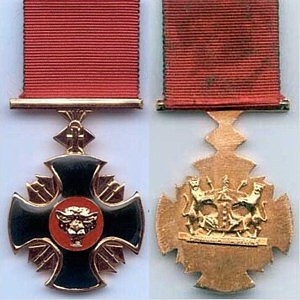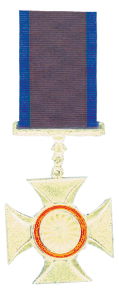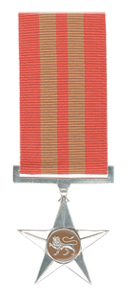
The Military Rule Medal was instituted by the State President of the Republic of Transkei to commemorate the bloodless 1987 military coup d'état which overthrew the Transkei government on 30 November 1987.

The Honoris Crux Gold, post-nominal letters HCG, is a South African military decoration for bravery which was instituted in 1975. It was awarded to members of the South African Defence Force for outstanding acts of bravery while in extreme danger. It was the second most senior in a set of four classes of Honoris Crux decorations which replaced the discontinued Honoris Crux of 1952.

The Pro Virtute Decoration, post-nominal letters PVD, is a military decoration for bravery which was instituted by the Republic of South Africa in 1987. It was awarded to officers of the South African Defence Force for distinguished conduct and exceptional leadership during combat operations in the field.

The Independence Medal was instituted by the State President of the Republic of Transkei to commemorate Independence on 26 October 1976. It was awarded to all ranks on the active strength of the Transkei Defence Force upon independence.

The Transkei Defence Force Medal was instituted by the State President of the Republic of Transkei for award to all ranks as a military medal for merit.

The Faithful Service Medal was instituted by the State President of the Republic of Transkei in 1987, for award to all ranks as a long service medal.

The Defence Force Merit Decoration was instituted by the State President of the Republic of Bophuthatswana in 1982, for award to officers for distinguished service of high quality and utmost devotion to duty.

The Distinguished Gallantry Cross was instituted by the State President of the Republic of Bophuthatswana in 1982, for award to all ranks for hair-raising deeds of distinguished heroism.

The Gallantry Cross, Gold was instituted by the President of the Republic of Venda in 1985, for award to all ranks for extreme courage or supreme bravery or valour beyond the normal call of duty.

The Gallantry Cross, Silver, post-nominal letters GCS, was instituted by the President of the Republic of Venda in 1985, for award to all ranks for courage or bravery or valour beyond the normal call of duty.

The Distinguished Service Medal, Gold was instituted by the President of the Republic of Venda in 1985, for award to all ranks for exceptionally meritorious service and particular devotion to duty.

The General Service Medal was instituted by the President of the Republic of Venda in 1985, for award to all ranks for service in defence of Venda or in the prevention or suppression of terrorism.

The Long Service Medal, Gold was instituted by the President of the Republic of Venda in 1985, for award to all ranks for thirty years exemplary service.

The Chief C.D.F. Commendation Medal was instituted by the President of the Republic of Ciskei in 1992, for award to all ranks for service commended by the Chief of the Ciskei Defence Force.

The Medal for Long Service, Bronze was instituted by the President of the Republic of Ciskei in 1988, for award to all ranks for ten years faithful service.

The Star for Bravery in Gold, post-nominal letters SBG, was instituted by the President of the Republic of South Africa in April 1996. It was awarded to veteran cadres of Umkhonto we Sizwe, the military wing of the African National Congress, who have distinguished themselves during the "struggle" by performing acts of exceptional bravery in great danger.

The Star for Bravery in Silver, post-nominal letters SBS, was instituted by the President of the Republic of South Africa in April 1996. It was awarded to veteran cadres of Umkhonto we Sizwe, the military wing of the African National Congress, who had distinguished themselves during the "struggle" by performing acts of bravery.

The Bravery Star in Silver, post-nominal letters BSS, was instituted by the President of the Republic of South Africa in April 1996. It was awarded to veteran cadres of the Azanian People's Liberation Army, the military wing of the Pan Africanist Congress, who had distinguished themselves during "the struggle" by performing acts of bravery.

The Gold Decoration for Merit, post-nominal letters GDM, was instituted by the President of the Republic of South Africa in April 1996. It was awarded to veteran cadres of the Azanian People's Liberation Army, the military wing of the Pan Africanist Congress, for outstanding service and utmost devotion to duty during the "struggle".

The Bronze Medal for Merit, post-nominal letters BMM, was instituted by the President of the Republic of South Africa in April 1996. It was awarded to veteran cadres of the Azanian People's Liberation Army, the military wing of the Pan Africanist Congress, for service of a high order during the "struggle".




















